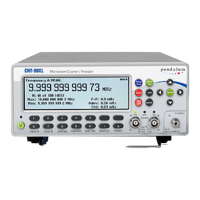channel B are enough to calculate the result,
Phase is the time difference between two sig-
nals of the same frequency, expressed as an
angle.
The traditional method to measure phase de-
lay with a timer/counter is a two-step process
consisting of two consecutive measurements,
first a period measurement and immediately
after that a time interval measurement. The
phase delay is then mathematically calculated
as:
360°x (Time Interval A- B )
or in other words:
Phase A -B = 360°x Time Delay x FREQ
A somewhat more elaborate method is used in
these counters. It allows the necessary mea-
s
urements to be performed in one pass by us-
ing tim
e-stamping. Two consecutive
time-stamps from trigger events on channel A
and two corresponding time-stamps from
Traditional phase definition.
The frequency range for phase is up to 160
MHz and the resolution depends on the
frequency. For frequencies below 100 kHz
the resolution is 0.001° and for frequencies
above 10 MHz it is 1°. It can be further
improved by averaging through the built-in
statistics functions.
Phase can be measured on input signal fre-
quencies up to 160 MHz. However, at these
very high frequencies the phase resolution is
reduced to:
100ps x 360° x FREQ
USER MANUAL ● CNT 9x Series ● Rev.22 February 2020

